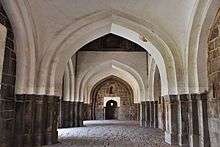Isa Khan Niazi
| Isa Khan Niazi | |
|---|---|
| Born | Delhi |
| Died |
16th Century Delhi |
| Nationality | Pashtun |
| Occupation | Afghan Noble |
Isa Khan Niazi (Pashto: عیسی خان نيازي) was a Pashtun noble in the courts of Sher Shah Suri and his son Islam Shah Suri, of the Sur dynasty, who fought the Mughal Empire.
Isa khan Niazi was born in 1453 and his last brother was born in 1478. He died in Delhi in 1548 at the age of 95. The time of 1451 – 1525 was the golden period for these khans. It was the time when Lodhis completely dominated the subcontinent (Hindustan). Isa Khan Niazi was a prominent member among the ruling family. He was in the same tribal unit of nobles as Ibrahim Lodhi, Sher Shah Suri. Most of these families were attached with the Delhi sultanate. There, a contention arose between Isa Khan Niazi and Sher Shah Suri which ended in mutiny.
Isa Khan's tomb complex


Tomb of Isa Khan
Isa Khan's tomb was built during his lifetime (ca 1547-48 AD). It is situated near the site of the Mughal Emperor Humayun's Tomb complex in Delhi which was built later (between 1562-1571 AD). Built within an enclosed octagonal garden, it bears a striking resemblance to other tombs of the Sur dynasty located in the Lodhi Gardens. This octagonal tomb has distinct ornamentation in the form of canopies, glazed tiles and lattice screens, and a deep veranda surrounding it, which is supported by pillars. It stands to the south of the Bu Halima garden at the entrance of the complex. An inscription on a red sandstone slab indicates that the tomb is that of Masnad Ali Isa Khan, son of Umar khan, the Chief chamberlain, and was built during the reign of Islam Shah Suri, son of Sher Shah, in 1547-48 A.D.[1] On 5 August 2011, restoration work on this tomb led to the discovery of India's oldest sunken garden. Isa Khan’s garden tomb is considered the earliest example of an Indian sunken garden attached to a tomb. This concept was later developed at Akbar’s Tomb and at the Taj Mahal.[2]
Mosque of Isa Khan

At the edge of the complex, across from the tomb, lies a mosque with noticeable mihrabs. It is known as Isa Khan's Mosque. It was built at the same time as the tomb. Many of the architectural details present in these structures (such as the tomb being placed in a walled garden enclosure) can be seen evolved to a grander scale in the main Humayun's tomb.[3]
Ancestry
Isa Khan Niazi belonged to the Jamalkhel clan of Niazi tribe.Family tree of Isa Khan Niazi is available in different historical books like Hayat Afghani by Muhammad Hayyat Khattar and Tareekh-e-Niazi Qabail by Muhammad Iqbal Khan Niazi Tajakhel and many more other books as well as in District Of Mianwali in Pakistan, his descendants are living in every part of the world specially in Isakhel, Mianwali (Isakhel was named after him by one of his descendants Ahmed Khan Niazi of Khanzaman Khel clan).
Isa Khan son of Umar Khan son of Khirr son of Jam son of Toor son of Hameem son of Wagan son of Jamal son of Niazi son of Ibrahim Loedy (The Great) (Not to be confused with Emperor Ibrahim Lodhi) son of Shah Hussain Prince of Ghour.
References
| Wikimedia Commons has media related to Isa Khan Niyazi's tomb. |